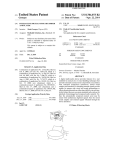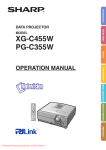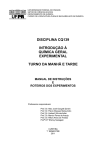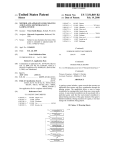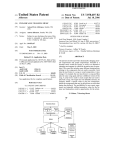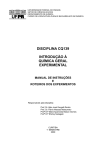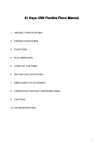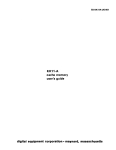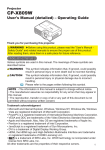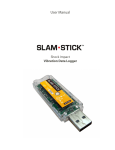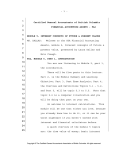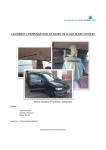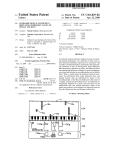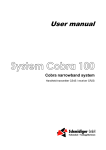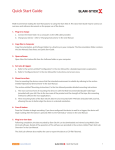Download l/ I) / I) (/ 121
Transcript
US006353167B1
(12) United States Patent
(10) Patent N0.2
Tuttle
(54)
(45) Date of Patent:
5,723,803 A * 3/1998 Kurakake
COMPUTER FOR CREATING MUSIC
5,801,694 A *
Inventor:
Raglan 'Ihttle, Colorado Springs, CO
.
.
Asslgnee: Raglan productlons’ Inc" Colorado
Notice:
Gabriel ...................... .. 84/609
5,892,507 A *
4/1999 Moorby et al.
5,908,997 A
*
6/1999 Arnold et al. .......... .. 84/478 X
5,915,288 A
*
6/1999
G b ' 1 ......... ..
5,931,680 A * 8/1999 sjmrilz ............... .. 84/477 R X
spnngs’ CO (Us)
(*)
9/1998 Gefshen
* 10/1998
57889519 A * 3/1999 Boezeman et al
(US)
(73)
Mar. 5, 2002
METHOD AND SYSTEM USINGA
5,824,933 A
(75)
US 6,353,167 B1
6,031,172 A
Subject to any disclaimer, the term of this
*
2/2000 Papadopoulos ......... .. 84/470 R
OTHER PUBLICATIONS
patent is extended or adjusted under 35
“
_
U_S_C_ 154(k)) by 0 days'
Sonic Foundry Presents ACID Music Dec. 14, 1998*
ACID User Manual, pp. 21—28, 1999*
_ ”
(21) Appl. No.: 09/465,212
* cited by examiner
(22) Filed:
Primary Examiner—Jeffrey Donels
Dec- 15’ 1999
(74) Attorney, Agent, or Firm—ToWnsend and ToWnsend
and Crew LLP
Related US. Application Data
(60)
Provisional application No. 60/122,551, ?led on Mar. 2,
1999, and provisional application No. 60/112,877, ?led on
(57)
ABSTRACT
Dec. 18, 1999.
(51)
Int Cl 7
G09B 15/02
A novel system and method for forming music. The system
includes a variety of elements such as a user interface on a
(52)
.... .. 84/477 R; 84/609
display. The user interface includes a ?rst portion on the
(58)
Field of Search ........................ .. 84/600, 609, 649,
display for a plurality of inputs, Which can be characteristics
of music. These characteristics tend to be the basic elements
84/464 R, 464 A, 470 R, 477 R
(56)
References Cited
of music such as pitch, tone, key, register, and others. The
user interface also includes a second portion on the display
U_S_ PATENT DOCUMENTS
for a patterned output. The output is representative to the
inputs. The output con?gures the inputs in a systematic
531533829 A
* 10/1992 Furuya et a1‘ """ " 84/477 R X
manner that alloWs a user to “view” the music in one easy
5,355,762 A
5,604,322 A
* 10/1994 Tabata .................... .. 84/609
* 2/1997 Kikuchi .................. .. 84/477R
to See dis 1a
p y‘
5,684,259 A
* 11/1997 Horii
5,690,496 A * 11/1997 Kennedy
17 Claims, 11 Drawing Sheets
143
Sound
Device
123
l/
I)
11
2
125
l/O
Controller
System
Memory
i
ll
127
/
129
I)
Central
Processor
Printer
11
ll
(/
121
l
‘
>
ll
11
11
ll
11
ll
Display
Adapter
l
/ 11
131
133
ll /
l
.
Momtor
135
ll /
137
V I/
Serial
Port
Keyboard
139
ll /
141
V I)
Fixed
External
Disk
interface
U.S. Patent
Mar. 5,2002
Sheet 1 0f 11
US 6,353,167 B1
100
101\
l
115
(g —/_1O3
115
113
FIG. 1
11s
1'
<
119x
D
‘\1o1
\___
\
116
FIG. 1A
__\
¥103
U.S. Patent
Mar. 5,2002
Sheet 2 0f 11
US 6,353,167 B1
A4
<
+
>
>
\
\
\
mihm?mm? \
\ ?20:
9b.5c8m0.aH9om
6c:h62o=w9>:Eo2i
Fm?mm?hm?:1
$320 63mu<
_
_
_
_
_
mxto2B0mE
Eu?ocBxwEmSe6n2?!
_\
N.QE
U.S. Patent
Mar. 5,2002
Sheet 3 0f 11
US 6,353,167 B1
3:30
FEG. 3
4013
5GB
FIG_ 5
U.S. Patent
Mar. 5,2002
Sheet 4 0f 11
US 6,353,167 B1
600
FIG. 6
700
531332315; 533233321“ m
U S Patent
Mar. 5,2002
Sheet 5 0f 11
US 6,353,167 B1
U.S. Patent
Mar. 5,2002
Sheet 6 6f 11
US 6,353,167 B1
800
Enharmonic
Tones Shown
Register Ball
FIG. 8
U.S. Patent
Mar. 5,2002
Sheet 7 0f 11
US 6,353,167 B1
The Tampa: Baii 5m
Tha Key 83%? ggg
'
“
Mde
T559
.
‘
..
.
._
__
.1
Mum
Memphis
‘
‘
Bmogie
The Védua? Keynmard Ba? {With enharmmni-c tong hidden}
\Mimr
Pantamniac
The ?agi‘ster Bail
‘E3139
61-51
The Structure Baii
Q11
‘
'
Triad
Ameggia
U.S. Patent
Mar. 5,2002
Sheet 8 0f 11
1iiiiii "
US 6,353,167 B1
1mm
19131
\)
U.S. Patent
Mar. 5,2002
Sheet 9 0f 11
US 6,353,167 B1
Composition
1105
1101
1109
1111
1103
1101 w
1) Keyball (a flat usage - Key of C)
1103 w
2) Revolution Ball (Indicates interval for
1105 J‘
3) Structure Ball
- repeating...)
1107 J‘ 4) Groove Ball (Indicates repeating pattern playing with a boogie bass.)
[Enharmonic tone hidden]
1109 ~/\ 5) Tempo Ball ( Indicates repeating pattern.)
[Enharmonic tone hidden]
1111 ~/\ 6) Vertical Keyboard Ball (Indicates major pentatonic scale.)
* Groove Ball #1, unlike Groove Ball #2, is adjacent to the Structure
Ball and to follow the cordal pattern indicated by the Structure Ball.
H The blue section (1113) indicates a blue note or "enharmonic tone".
FIG. 11
U.S. Patent
Mar. 5,2002
Sheet 10 0f 11
US 6,353,167 B1
U.S. Patent
Mar. 5,2002
Sheet 11 0f 11
US 6,353,167 B1
131E313
US 6,353,167 B1
1
2
METHOD AND SYSTEM USING A
COMPUTER FOR CREATING MUSIC
among others, computers on a Wide area netWork such as the
Internet, notebook computers, laptop computers, palmtop
computers, personal digital assistants, and the like. Signal
processing can also occur in the computer.
CROSS REFERENCE TO RELATED
APPLICATIONS
In a speci?c embodiment, the present invention provides
a novel system for forming music. The system includes a
The present application claims priority to US. Ser. No.
60/122,551 ?led Mar. 2, 1999 and US. Ser. No. 60/112,877
variety of elements such as a graphical user interface on a
?led Dec. 18, 1999, and hereby incorporated by reference
display for a plurality of inputs, Which can be characteristics
of music. These characteristics tend to be the basic elements
of music such as pitch, tone, key, register, and other param
for all purposes.
display. The user interface includes a ?rst portion on the
10
COPYRIGHT NOTIFICATION
eters that de?ne music. The user interface also includes a
Aportion of this document, such as the computer code, is
second portion on the display for a patterned output. The
subject to Copyright protection. Notice of such Copyright
protection is provided herein. Applicant expressly reserves
the inputs in a systematic manner that alloWs a user to
output is representative to the inputs. The output con?gures
15
all rights subject to the extent of Copyright laWs © 1999.
BACKGROUND OF THE INVENTION
The present invention relates to music theory. More
particularly, the present invention provides a technique for
forming music. In an exemplary embodiment, the present
invention provides a method and apparatus for teaching
music theory based upon an improved graphical user inter
face in a microprocessor based system. Merely by Way of
example, the present invention can be applied to a computer;
but it Will be recogniZed that the invention has a much
broader range of applicability. It can be applied to computers
20
tones based upon a series of music rules. Accordingly, the
present invention alloWs the user to play the music that is
represented by the pattern, Which Was created by the user.
In an alternative speci?c embodiment, the present inven
tion provides a method for forming music on a computer,
e.g., laptop, notebook, netWork, and others The method
includes providing a user display, Where the user display has
a ?rst portion. The ?rst portion includes one or more
25
indications Which de?ne music characteristics. These indi
cations can be in the form of icons or tools, for example. The
music characteristics include, among others, tone, pitch, key,
and register. The method includes a step of selecting one of
the indications that correspond to one of the music charac
on a Wide area netWork such as the Internet, notebook
computers, laptop computers, palmtop computers, personal
digital assistants, and the like.
Avariety of techniques have been proposed for teaching
“vieW” the music in one easy to see display. Additionally, the
patterned output is coupled to underlying sounds and/or
30
teristics. Selection can occur, for example, by visually
selecting the indication(s) and mechanically using a mouse,
keyboard, or other input device for electronically selecting
and creating music. A classical and most often used method
one or more of the indications. The method also includes
relies upon teaching a student via a keyboard using simple
songs and playing simple scales and chords. As merely an
example, a beginning piano student often learns hoW to play
piano by playing via a keyboard simple songs such as
placing the selected indication on a second portion of the
display. In some embodiments, the second portion of the
display is called a palette, Which can be analogiZed to a
blank piece of paper for a draWing. The icons representing
the music characteristics are placed on the palette using, for
example, a drag and drop technique of the mouse, but is not
“Marry Had a Little Lamb” or Fur Elise by Bethoven The
beginning piano student also learns hoW to play chords and
scales, as Well. For example, the student may learn hoW to
play a C major scale and others. Over time, the student
progresses and learns hoW to play more advanced scales,
songs, and the like. In most cases, hoWever, the student often
fails to learn details of music theory and the like to create his
or her oWn music by simple keyboard instruction.
There have been some other techniques to teach music
students the theory of music. These techniques often come
in the form of college or graduate school education. An
example of one of these techniques is the use of visual aids
in order to replace keyboard instructions. US. Pat. No.
4,887,507, Which is in the name of Terrance ShaW (herein
40
characteristics to de?ne his or her music. Once one or a set
of characteristics are selected, the method plays the music,
Which is based upon the characteristics. The user can listen
to the music, Which has been created by the present user
45
Numerous bene?ts are achieved by Way of the present
50
teaching and creating music. Additionally, the present inven
55
tion provides a patterned output that can de?ne the music in
a spatial and graphical form. The patterned output can be
played in the form of audio output in some embodiments to
alloW the user to listen to the neWly formed music. The
present invention can be implemented on conventional hard
Ware such as a personal computer and the like. These and
other bene?ts are described throughout the present speci?
standing and/or forming music that is easy to implement is
highly desired.
SUMMARY OF THE INVENTION
60
a method and apparatus for forming music is provided. In an
an improved graphical user interface in a microprocessor
based system. The microprocessor based system includes,
cation and more particularly beloW.
The present invention achieves these bene?ts in the
context of knoWn process technology. HoWever, a further
understanding of the nature and advantages of the present
invention may be realiZed by reference to the latter portions
of the speci?cation and attached draWings.
According to the present invention, a technique including
exemplary embodiment, the present invention provides a
method and apparatus for teaching music theory based upon
display.
invention. Depending upon the embodiment, one or more of
these bene?ts can be present. In one aspect, the present
invention provides an easy to use softWare interface for
“ShaW”), describes a visual technique for teaching music.
ShaW generally describes a complex mechanical device With
moving Wheels and a base member. Although someWhat
effective, ShaW still fails to provide an easy Way for an
average music student to learn and create music.
From the above, it is seem that a technique for under
limited to this technique. Here, the user can rely on his or her
oWn creativity in properly selecting one or more of the music
65
BRIEF DESCRIPTION OF THE DRAWINGS
FIGS. 1—2 are simpli?ed system diagrams according to
embodiments of the present invention;
US 6,353,167 B1
4
3
FIGS. 3—5 are simpli?ed diagrams of displays of rhythmic
127, a printer 129, a display adapter 131, a monitor 133, a
serial port 135, a keyboard 137, a ?Xed disk 139, an eXternal
interface 141, and other elements. The sub-systems also
elements according to embodiments of the present inven
tion;
include a sound device 143, such as a sound card or
FIGS. 6—8 arc simpli?ed diagrams of displays of tones
according to embodiments of the present invention;
FIG. 9 is a simpli?ed diagram of a register ball display
according to an embodiment of the present invention; and
FIGS. 10—13 are tone diagrams displays according to
embodiments of the present invention
integrated circuit chip, Which is coupled to audio output
devices. The audio output devices can be any suitable
speakers or the like. In some embodiments, the sub-system
also includes a digital signal processor or DSP integrated
circuit chip to edit and con?gure sounds.
10
DESCRIPTION OF THE SPECIFIC
EMBODIMENTS
According to the present invention, a technique including
a method and system for forming music is provided. In an
exemplary embodiment, the present invention provides a
method and apparatus for teaching music theory based upon
15
an improved graphical user interface (“GUI”) in a micro
processor based system. The microprocessor based system
can be a computer, a Workstation, a netWork computer, a
portable computer, a notebook computer, a palmtop
computer, and other interface devices.
FIG. 1 is a simpli?ed diagram of a system according to an
embodiment of the present invention. This diagram is
merely an eXample and should not limit the scope of the
claims herein. One of ordinary skill in the art Would recog
niZe other variations, modi?cations, and alternatives. The
In a speci?c embodiment, the sound device includes an
audio processor. The audio processor takes information from
the inputs on the user display, and converts the inputs via
music rules to sounds. The sounds are made by Way of calls
to an operating system, Which, in turn, drives the audio
processor and outputs the sounds, Which are based upon the
music rules and inputs from the user interface. The audio
processor can be in the form of hardWare. Alternatively, it
can be in the form of softWare. Still further, it can be in the
form of a combination of hardWare and softWare, depending
upon the application. As merely an eXample, the computer
can output sounds and connect to other devices using a
standard Musical Instrument Digital Interface, Which is
commonly called MIDI.
25
system 100 includes a variety of elements such as a display
device 101, a display screen 103, a cabinet 105, a keyboard
FIG. 1A is a more detailed diagram of a display 101
according to an embodiment of the present invention. This
diagram is merely an eXample and should not limit the scope
of the claims herein. One of ordinary skill in the art Would
recogniZe other variations, modi?cations, and alternatives.
Some reference numerals used in FIG. 1A are similar to the
111, a high capacity memory device 113, a set of speakers
ones used above for cross-referencing purposes. As shoWn,
display 101 has graphical user interface device 119, Which
115, and a mouse 109. The mouse and keyboard illustrate
“user input devices.” Mouse 109 also has a right click button
and left click button 107, Which are used in the present
is an input screen, and user device, Which is an output
screen. The input screen is actually a tool or selection menu.
screen, light pen, track ball, data glove, speech recognition 35 In one embodiment, the input screen can be similar to a
keyboard or considered as a “virtual keyboard,” Which is
unit, and the like. The display also has graphical user
invention. Other examples of user input devices are a touch
input screen can be similar to a keyboard or considered as a
used to input or choose selected music information. The
music information is used to understand and form music, for
eXample. The virtual keyboard can be in the form of icons
or other indications, Which can be selected. EXamples of the
“virtual keyboard,” Which is used to input selected music
input screen are shoWn in more detail beloW.
information. The music information is used to understand
and form music, for eXample. The output screen is an output
based upon the input screen according to the present inven
The output screen 116 is an output based upon the input
screen according to the present invention. The output screen
interface device 119, Which is an input screen, and user
device 117, Which is an output screen. The input screen is
actually a tool or selection menu. In one embodiment, the
tion. The output screen visually displays patterns associated
With the resulting music, Which is based, in part, on the input
visually displays patterns associated With the resulting
45
music, Which is based, in part, on the input or inputs. The
output screen can be similar to a Work space or an area Where
or inputs. Further details of the input and output are shoWn
beloW.
The PC based system includes a PENTIUMTM Micropro
music information is accumulated to form music. Once
selected music information is placed on the output screen.
cessor by Intel Corporation of Santa Clara, Calif. The system
also runs a WindoWsTM based operating system.
of many controls on screen portion 118. Further details of
the output are shoWn beloW.
Alternatively, the system can be from AppleR of Cupertino,
Calif., Which runs an AppleR operating system. Other sys
screen portion 119. The music information includes, tone,
The music is composed and can be played by selecting one
In one embodiment, a user selects music information from
tems such as those that are PC based, as Well as NT based,
key, structure, and others. In one aspect, the user clicks onto
and the like can also be used. The present system is not
intended to limit the scope of the claims herein, but requires
a suitable amount of memory and processing poWer to carry
55 an icon for the desired music information from screen
portion 119 and drags the icon into screen portion 116. Other
icons that correspond to other music information can also be
selected. Once all the selections have been made, the user
out one or more of the embodiments of the present inven
tion.
music is composed. The user can play the music by selecting
FIG. 2 is a simpli?ed diagram of sub-systems in the
system of FIG. 1 according to an embodiment of the present
invention. This diagram is merely an eXample and should
not limit the scope of the claims herein. One of ordinary skill
in the art Would recogniZe other variations, modi?cations,
and alternatives. Among others, the sub-systems in the
one of the control keys in screen portion 118. These and
other operations can be made by Way of the present inven
tion.
system include, for eXample, a common bus 121, an I/O
controller 123, a system memory 125, a central processor
The present system can be replaced, in part, by other
hardWare. The hardWare can be more integrated or even
65
separated. The computer system can also include other types
of computers such as a Workstation, a netWork computer, a
portable computer, a notebook computer, a palmtop
US 6,353,167 B1
5
6
computer, and other computing devices. These devices
either 1, 2, 3, 4, 5, 6, 7, 8, 9, 10, 11, and 12 units respectively
Would include a novel program and graphical user interface
or virtual keyboard according to one of more embodiments
Would represent the tWelve (“12”) notes of Western music
and also four beats of “sWinging” eighth notes. In other
embodiments, a register is also provided in combination
of the present invention. The FIGS. beloW describe addi
tional details With regard to the present invention.
FIGS. 3—5 are simpli?ed diagrams of rhythmic elements
for screen displays according to embodiments of the present
invention. These diagrams are merely eXamples and should
not limit the scope of the claims herein. One of ordinary skill
in the art Would recogniZe other variations, modi?cations,
and alternatives. As merely an example, the present
invention, Which is also called the RagZbolTM notation
system, divides rhythmic elements such as tempo, for
eXample. One of a plurality of tempos is placed in a
graphical user interface form, Which can be accessed via
keyboard or mouse, as Well as other devices. By Way of
clicking on one of the tempos, the present system outputs
such tempo in an audio manner through a speaker, for
With rhythm and pitch.
10
disk 801, Which is divided in a manner similar to the FIGS.
15
eXample. The user interface can be shaped as a disk 300
sliced into four equal sections 301. The disk 300 represents
four quarter notes. Such a disc Would equal four quarter
notes or one measure When in 4/4 time. A disc 400 divided
into eight equal sections 401 Would represent eight eighth
notes. One revolution of such a disc Would also equal one
measure When in 4/4 time. A disc 500 divided into 3 equal
25
sections 501 Would represent three quarter notes or one
measure in 3/4 time. Other eXamples such as 2/4 time, and
others can also be represented as a disk or other graphical
form, e.g., polygon.
FIGS. 6—7 are simpli?ed diagrams of screen displays for
pitch according to embodiments of the present invention.
These diagrams are merely eXamples and should not limit
the scope of the claims herein. One of ordinary skill in the
art Would recogniZe other variations, modi?cations, and
alternatives. The present pitch diagrams can be represented
35
in one of many Ways. In one embodiment, the present user
interface can be divided into sections in a similar manner as
sented in a disk 600, 700. Such disk 600 can be divided into
tone is placed betWeen C2 and B2 using the red portions,
Where the black portions 805 represent black keys and the
blue portions 805A represent the White keys.
A larger annular region 806 is formed concentrically
around the center disk. The larger annular region designates
a register. Here, a “Boogie-Woogie” base-line played tWo
octaves (i.e., C2—B2) beloW middle C is depicted. Outer
annular region 806 designates a register about middle C,
Where position does not matter. Alternatively, the outer
annular region can be placed in an inner region of the disk
801.
FIG. 9 is a simpli?ed diagram of an input device accord
ing to an embodiment of the present invention. The input
device is used for programming purposes, for eXample. The
input device also can be used for teaching purposes, for
eXample. The input device can be used in combination With
the keyboard or mouse or voice activated device, as Well as
reference to the FIG.
1. The tempo ball 901 includes a collection of balls
tWelve (“12”) equal sections such as these shoWn in the
pie-like con?guration. Each section represents a pitch, e.g.,
representing various tempos such as 40 bps (“beats per
second”), 50 bps, 60 bps, etc. Here, the tempo could be
A, A#, B, B#, C, C#, D, D#, E, F, F#, G, G#, Which forms
one set of keys on, for eXample, a keyboard similar to a
piano. The tWelve sections also represent the tWelve (“12”)
45
To fully illustrate, for eXample, the diagram of FIG. 6, it
may assist the reader to revieW FIG. 6A. Here, a register of
a standard piano keyboard 601 is shoWn. The standard piano
keyboard includes White keys, Which represent each full
note, e.g., A, B, C, D, E, F, G. The black keys represent half
steps, including A#, B#, C#, D#, F# and G#. These keys are
continuous, Which can be adjusted in a continuous sliding
scale manner. Alternatively, the tempo could be quantiZed.
2. The key ball 903 is used to designate a key or tonal
center. The key ball includes 12 balls representing the 12
notes of Western music, e.g., C, C#, D, D#.
3. The groove ball 905 can include looping MIDI record
ings of various basic piano. The ball compiles styles such as
“Stride,” “Shuffle,” “Straight Eight Boogie,” “Memphis,”
“Blues,” and others. The duration of these recordings
depends on the length of the rhythmic phrase, for instance,
folded toWard each other in a circular con?guration such as
the folded structure 603, Which has each end of the register
closing in on each other. Once the circular con?guration
ends are attached to each other 605, tWelve keys are shoWn
above, but is not limited. The center disk is divided into
tWelve pie-like 803 sections about a center region of the
disk. Additionally, the center disk is divided concentrically
about a center region into tWelve concentric regions, each
having a larger radius. In the center disk, the red portions
807 designate the key, Which repeats about the tone. The
other input means. The input device includes a variety of
parameters, Which can be selected, for creating and analyZ
ing music. These parameters or elements are described in
in the above paragraph. Accordingly, pitch can be repre
notes of Western music’s tonal system.
FIG. 8 is a simpli?ed diagram 800 of a display of a
register ball according to an embodiment of the present
invention. This diagram is merely an illustration and should
not limit the scope of the claims herein. One of ordinary skill
in the art Would recogniZe other variations, alternatives, and
modi?cations. The present register ball 800 includes a center
a Stride groove Would be 4 beats in length, a Memphis
55
groove eight beats, and Boogie-Woogie four or eight beats
in a circular arrangement. These keys include A, A#, B, B#,
C, C#, D, D#, E, F, F#, G, G#. The representation of FIG. 6A
should assist the reader in deriving the structure of FIG. 6,
depending on the base line. The groove ball is the basic
for eXample, as Well as other FIGS. herein.
balls representing the seven modes, major and minor pen
rhythm ball, Which is similar to the rhythm ball.
4. The virtual keyboard 907 ball can be a collection of
tatonic scales, major and minor blues scales, arpeggios of
major and minor triads, arpeggios of major and minor
In an alternative embodiment, rhythm and pitch can be
represented on a single disk 700, such as the one shoWn in
FIG. 7. The disk illustrates a combination of rhythm and
pitch in a graphical manner. As merely an eXample, disc 700
can be sliced into 12 equal sections similar to the sections in
the above FIG. Additionally, the disk is further divided about
a center region in a concentric manner. Each region has a
different radius about the same center point. A radius of
seventh chords, the chromatic scale, and other balls repre
65
senting other simple harmonic structures, for eXample, JaZZ
musicians typically employ While improvising melodic lines
in various styles. The keyboard ball represents the entire
body of scale or mode, Which de?nes a mode such as
miXalidian, etc. See FIG. 13.
US 6,353,167 B1
8
7
C4 since neither key nor register ball has been dragged on
to palette). Moving in a clockWise direction from the
section, the ?ve sections of this ball represent the notes C,
5. The register ball 909 can be a collection of balls
representing the various registers, e.g., C1 to B1, C2 to B2,
C3 to B3.
6. The structure ball 911 can be a collection of balls
Eb, F, G, and Bb respectively. Inside of this Virtual Key
representing various structures typically employed in J an or
board ball is a red dot 1009 representing the mouse pointer.
Moving this pointer over one of the ?ve sections of the
Blues (e.g., 12 bar blues, 16 bar blues) performance. This
generally describes the harmonic portion of the music, e.g.,
blues, jaZZ. One Way goes in half steps, Which is the standard
Way of going up or doWn the keys. The other dimension
Which is placed perpendicular goes up in fourth steps
10
(perfect forth steps).
7. The duration ball designates a particular number of
revolutions for the structure ball. For example, a blues
simpli?ed example of sheet music 1100, Which is typically
composition including four choruses Would employ a #4
duration ball.
The features noted above can be implemented on a portion
of the display. Depending upon the embodiment, a user
15
device such as a mouse can be used to click onto one of the
features in the FIG. Alternatively, the present features can
include another element such as a palette. The palette is a
designated area of the display on the computer, Which is
used to drop one or more of the features noted. The palette
is similar to “a blank sheet of paper,” Where a user can begin
to design the music using one or more of the features noted.
The user can direct a cursor to click onto one or more of the 25
features, Which are dragged and dropped onto the palette.
In a speci?c embodiment, the present invention uses rules
to couple or connect the various features With the ?nal
output, Which is in the form of a patterned disk, for example.
The rules connecting the various features can be analogous
to the rules connecting the various musical elements in J an
performance. For instance, the selection of a tempo ball in
Which a quarter note equals 120 beats per second, sets the
tempo. The ball containing the rhythmic information can
rotate and perform their musical content (just as in a
standard sequencing program, the selection of a tempo
dictates the pace for all the other rhythmic elements of a
indicates a repeating pattern of notes that represents a
35
Boogie Bass.
Groove ball (#2): The groove ball is in a combination of
orange, red, and yelloW colors 1109. As shoWn, the groove
ball indicates a repeating pattern.
Virtual keyboard ball: The virtual keyboard ball is in a
yelloW color 1111. As shoWn, the virtual keyboard ball
indicates a major pentatonic scale.
The present invention can be implemented in one or more 45
examples. These examples, Which are referenced by Way of
the FIGS. shoW the operation of embodiments of the present
The examples shoWn above illustrate that sheet music can
be converted into a graphical notation. Alternatively, the
graphical notation, Which is the pattern, could be converted
into sheet music. Accordingly, the present invention can be
used to analyZe music, Which has been converted from sheet.
Alternatively, the present invention can be used to create
sheet music, once a desirable music pattern is found. These
and other embodiments Will be recogniZed by one of ordi
nary skill in the art.
invention. FIG. 10 is a simpli?ed example of a user display
according to an embodiment of the present invention. This
FIG. is merely an example and should not limit the scope of
the claims herein. One of ordinary skill in the art Would
Although the above has been generally described in
speci?c hardWare and softWare elements, the present inven
recogniZe other variations, modi?cations, and alternatives.
Referring to FIG. 10, depicted at the top of the interface
tion can be applied in many other Ways. For example, the
present invention can be applied further separated in terms
are three buttons. These are, going from left to right, include
55
BeloW the icons is a palette region. Three features, Which are
depicted as icons 1007, are dragged from the features region
to the palette. As shoWn, the outer most 1013 is a groove ball
of hardWare and/or softWare. Additionally, the present
invention can be applied in terms of more integrated soft
Ware. Depending upon the embodiment, the present inven
tion can also be applied in more integrated hardWare such as
chips, or the like.
FIG. 13 is a simpli?ed display diagram of a virtual ball
1300 according to an embodiment of the present invention.
This diagram is merely an illustration and should not limit
the scope of the claims herein. One of ordinary skill in the
1013. Since no structure or duration ball has been dragged
Keyboard ball 1011 (defaulted to the key of C and register
shoWn, there are no ?ats or sharps. The key is in C, but can
be others.
Revolution ball: The revolution ball is in a combination of
yelloW and green colors 1103. As shoWn, the revolution ball
shoWs a division of tWo segments, Which represent tWo
choruses.
Structure ball: The structure ball is in a combination of
For example, use of a standard “12 Bar Blues Structure Ball”
Would mean that in bar 5 of a “Boogie-Woogie” perfor
mance the Bass Would noW play its repeating 4 beat pattern
beginning on the fourth scale degree rather than the ?rst.
onto the palette, this musical ?gure Will continue to loop
until the stop icon is clicked. Only one note is being played
(since no “key” or “register” ball has been dragged onto the
palette this note defaults to C2) and it is playing a sWinging
eight note rhythm (since no tempo ball has been dragged
onto the palette this rhythm has defaulted to 120 bps).
Inside of the groove ball is the Minor Pentatonic Virtual
played on a piano. For easy reading and cross-referencing,
FIGS. 11—12 have been color coded. A legend for the color
coding is provided in the loWer portion of FIG. 11. FIG. 12
is a simpli?ed illustration of graphical patterns 1200 accord
ing to the present invention. The graphical patterns can be
displayed on a computer display. The legend describes the
folloWing layers or regions of the pattern of the FIGS.
Key ball: The key ball is shoWn in the color red 1101. As
blue and purple colors 1105. As shoWn, the structure ball
includes the number of bars and chords.
Groove ball (#1): The groove ball is in a combination of
red and yelloW colors 1107. As shoWn, the groove ball
piece of music). Also, similar to the Way a J an performance
mirrors the content of a musical chart, the patterned output
maps out the harmonic information of a given performance.
recording icons reWind 1001, stop 1003, and play 1005.
virtual keyboard ball triggers Whatever note that section
happens to represent.
FIGS. 11—12 are simpli?ed diagrams of other examples
according to the present invention. These diagrams are
merely examples and should not limit the scope of the claims
herein. One of ordinary skill in the art Would recogniZe other
variations, modi?cations, and alternatives. FIG. 11 is a
art Would recogniZe other variations, modi?cations, and
65
alternatives. The display diagram can be a collection of balls
representing the seven modes 1301, major and minor pen
tatonic scales, major and minor blues scales, arpeggios of
US 6,353,167 B1
9
10
major and minor triads, arpeggios of major and minor
seventh chords, the chromatic scale, and other balls repre
senting other simple harmonic structures, for example, J an
musicians typically employ While improvising melodic lines
in various styles. The keyboard ball represents the entire 5
body of scale or mode, Which de?nes a mode such as
mixalidian, etc. Although the diagram is shoWn in a circular
arrangement, it can also be in the form of a linear
arrangement, a polygon, and other shapes, as Well as siZes.
10
EXAMPLE
To prove the principle and operation of the present
invention, examples Were made Which implemented the
present invention. Certain aspects of the present invention
Were implemented on a computer system. The computer 15
system Was a MacIntoshTM computer made by a company
called Apple Computer, Inc. of Cupertino, Calif. The system
Was loaded With a computer softWare program called MAX
from Opcode Systems Inc. The program is generally an
interactive real-time graphic programming environment for 20
multimedia applications. MAX is object oriented, and
alloWs the user to program by Way of graphical techniques.
Max includes a variety of objects and features including, for
example, device control (e.g., MIDI devices, CD audio), 25
MIDI support, user interface, graphics, timing, and others.
Further details of MAX can be found at http://
WWW.opcode.com/products/max/, Which is incorporated by
reference herein. Aspects of the present invention Were
programmed using MAX. An example of computer code, 30
Which Was implemented on MAX is provided beloW.
max v2;
#N vpatcher 100 46 722 466;
#P button 151 66 15 0;
#P message 608 317 23 196617 Zero;
#P
#P
#P
#P
#P
message 102 22 52 196617 stop;
message 103 1 58 196617 start 1024;
hidden neWex 146 433 35 196617 metro;
hidden toggle 121 392 15 0;
hidden button —31 459 15 0;
35
40
#N vpatcher 635 450 638 478;
#P outlet 182 629 15 0;
#P neWex 48 290 105 196617 if $i1==0 then set 1;
45
#P user uslider 35 39 18 128 13 1 0 0;
#P comment 240 603 100 196617 Out to Movie “Next”;
#P comment 240 66 100 196617 Inlet from Seq MidiParse
Patch Change #;
#P
#P
#P
#P
#P
#P
comment 224 123
button 558 281 15
button 205 284 15
button 339 287 15
button 444 283 15
comment 473 190
50
100 196617 Patch #;
0;
0;
0;
55
0;
62 196617 int in left inlet selects
gate outlet;
#P
#P
#P
#P
#P
#P
#P
#P
comment
comment
comment
comment
comment
comment
comment
comment
196 40 47 196622 gate;
53 266 100 196617 BASIC is the default;
192 311 100 196617 MIXOLYDIAN;
850 537 100 196617 IONIAN;
730 539 100 196617 LYDIAN;
626 542 100 196617 PENT 5;
511 541 100 196617 PENT 4;
392 544 100 196617 PENT 3;
60
65
#P
#P
#P
#P
#P
#P
#P
#P
#P
#P
#P
#P
#P
#P
#P
#P
#P
#P
#P
#P
#P
#P
#P
#P
#P
#P
#P
#P
#P
#P
#P
#P
#P
#P
#P
#P
#P
#P
#P
#P
#P
#P
#P
#P
#P
#P
#P
#P
#P
#P
#P
#P
#P
#P
#P
#P
comment 285 544 100 196617 PENT 2;
comment 774 305 100 196617 PENT 1;
comment 649 306 100 196617 LOCRIAN;
comment 532 309 100 196617 PHRYGIAN;
comment 419 309 100 196617 AOLEAN;
comment 301 310 100 196617 DORIAN;
button 786 281005 0;
button 668 286 15 0;
button 512 521 15 0;
button 403 523 15 0;
button 291 523 15 0;
button 624 520 15 0;
button 853 514 15 0;
button 737 516 15 0;
number 223 141 35 9 0 0 0 3;
inlet 220 77 15 0;
neWex 646 259 105 196617 if $i1==5 then set 1;
neWex 404 257 105 196617 if $i1==3 then set 1;
neWex 292 260 105 196617 if $i1==2 then set 1;
neWex 182 262 105 196617 if $i1==1 then set 1;
neWex 283 497 105 196617 if $i1==7 then set 1;
neWex 758 258 105 196617 if $i ==6 then set 1;
neWex 393 495 105 196617 if $i1==8 then set 1;
neWex 500 492 105 196617 if $i ==9 then set 1;
neWex 531 258 105 196617 if $i1==4 then set 1;
neWex 724 484 111 196617 if $i1==11 then set 1;
neWex 608 490 111 196617 if $i1==10 then set 1;
neWex 844 480 111 196617 if $i1==12 then set 1;
outlet 200 631 15 0;
outlet 224 630 15 0;
outlet 244 631 15 0;
outlet 276 631 15 0;
outlet 303 626 15 0;
outlet 329 622 15 0;
outlet 357 621 15 0;
outlet 387 617 15 0;
outlet 410 617 15 0;
outlet 435 615 15 0;
outlet 459 615 15 0;
outlet 478 618 15 0;
connect 24 0 56 0;
connect 25 0 57 0;
connect 25 0 20 0;
connect 57 0 58 0;
connect 20 0 11 0;
connect 20 0 51 0;
connect 56 0 25 0;
connect 21 0 10 0;
connect 22 0 9 0;
connect 15 0 8 0;
connect 25 0 19 0;
connect 19 0 29 0;
connect 25 0 21 0;
connect 23 0 7 0;
connect 18 0 6 0;
connect 21 0 50 0;
US 6,353,167 B1
11
#P
#P
#P
#P
#P
#P
#P
#P
#P
#P
#P
#P
#P
#P
#P
#P
#P
#P
#P
#P
#P
#P
#P
#P
#P
connect
connect
connect
connect
connect
connect
connect
connect
connect
connect
connect
connect
connect
connect
connect
connect
connect
connect
connect
connect
connect
connect
connect
connect
pop;
19
17
25
17
25
16
13
22
14
12
25
16
25
15
25
13
25
23
25
14
25
18
25
12
0
0
0
0
0
0
0
0
0
0
0
0
0
0
0
0
0
0
0
0
0
0
0
0
5 0;
4 0;
17 0;
30 0;
22 0;
3 0;
2 0;
49 0;
1 0;
0 0;
16 0;
31 0;
15 0;
52 0;
13 0;
28 0;
23 0;
32 0;
14 0;
26 0;
18 0;
33 0;
12 0;
27 0;
12
#P button —41 238 15 0;
#P comment 63 53 141 196617 ‘bang’ to play at default
speed;
#P comment 63 69 194 196617 ‘start’ (tempo) With
1024=normal speed;
#P comment 63 86 124 196617 stop recording and play
10
event;
#P comment 63 155 178 196617 print out ?rst feW events
in sequence;
#P comment 63 202 163 196617 save as a MIDI or teXt
15
neWeX 127 405 41 196617 midiout;
inlet —112 157 15 0;
inlet —128 157 15 0;
comment —117 32 100 196617 MIDI sequencer;
#P neWeX —82 214 27 196617 seq;
20
25
30
user kslider 483 328 54 0 36 48 31 12;
number 730 426 35 9 0 0 0 3;
number 403 426 35 9 0 0 0 3;
neWeX 403 490 158 196617 noteout 1;
neWeX 403 456 158 196617 makenote 80 100;
35
40
45
#P outlet 242 433 15 0;
#P number 332 396 35 9 0 0 0 3;
#P message 6 120 52 196617 read;
#P message 649 —33 158 1441802 play 1 2 3 4 5 6 7 8 9
10;
#P comment 232 51 100 196617 MIDI sequencer;
#P user umenu 354 26 83 196647 1 64;
#P
#P
#P
#P
#P
#P
#P
55
#P number —65 337 35 9 0 0 0 3;
#P neWeX —52 560 40 196617 unpack;
#P number —52 582 27 9 0 0 0 3;
#P button —71 615 15 0;
#P number —22 582 28 9 0 0 0 3;
#P number 40 582 28 9 0 0 0 3;
#P number 10 582 27 9 0 0 0 3;
#P neWeX 10 560 40 196617 unpack;
#P number 101 582 28 9 0 0 0 3;
#P number 71 582 27 9 0 0 0 3;
#P neWeX 71 560 40 196617 unpack;
#P number 134 560 28 9 0 0 0 3;
#P button 134 582 15 0;
#P neWeX —52 534 340 196617 midiparse;
#P number 278 560 28 9 0 0 0 3;
#P button 278 582 15 0;
#P number 223 560 28 9 0 0 0 3;
#P button 223 582 15 0;
#P button 180 582 15 0;
#P number 180 560 28 9 0 0 0 3;
#P comment —50 632 300 196617 Midiparse parses raW
MIDI bytes into ints or lists of tWo ints. Each outlet is
a different MIDI message type.;
#P comment 362 67 59 196617 ints interpreted as MIDI
bytes;
#P neWeX 355 48 50 196617 midiin;
60
#P comment 354 11 62 196617 Input device:;
#P hidden neWeX 278 14 49 196617 omsinfo;
#P hidden neWeX 278 —26 52 196617 loadbang;
#P hidden message 278 —5 64 196617 controllers;
#P comment —24 239 272 196617 bang sent out right
outlet When sequence comes to the end;
message 6 154 52 196617 print;
message 6 137 52 196617 delay 0;
message 6 103 52 196617 record;
message 7 71 58 196617 start 1024;
button 6 52 15 0;
message 6 86 52 196617 stop;
comment —37 218 224 196617 optional argument to
read in a MIDI or teXt ?le;
#P comment —117 58 62 196617 Input device:;
#P
#P
#P
#P
#p
#P message 6 198 52 196617 Write;
#P comment 63 173 166 196617 read (optional ?lename)
from a teXt or MIDI ?le;
#P user umenu —117 73 83 196647 1 64;
#P neWeX —116 95 50 196617 midiin;
?le;
#P message 531 38 52 196617 read;
#P hidden neWobj —33 112 187 196617 patcher MODE;
#N vpatcher 83 120 615 363;
#P
#P
#P
#P
mg;
#P comment 63 103 77 196617 start recording;
#P comment 63 137 140 196617 set onset delay of ?rst
65
#P
#P
#P
#P
#P
#P
#P
#P
button 10 600 15 0;
button 71 600 15 0;
comment 25 598 47 196617 Poly Pressure;
comment —36 599 38 196617 Note On/Off;
comment 89 599 44 196617 Control Change;
comment 262 599 41 196617 MIDI Channel;
comment 178 599 34 196617 After Touch;
comment 133 599 40 196617 Pgm Change;
US 6,353,167 B1
14
13
#P comment 221 599 32 196617 Pitch Bend;
#P comment —66 514 204 196617 Separate raW MIDI
bytes by message type;
#P
#P
#P
#P
comment —64 482 83 196622 midiparse;
message 457 60 48 1441802 ?rst 0;
message 461 113 40 1441802 stop;
message 642 16 40 1441802 play;
#P neWeX 507 177 199 1441802 mtr 10;
#P color 5;
#P
#P
#P
#P
#P
#P
#P
#P
#P
#P
#P
#P
#P
#P
#P
#P
#P
#P
#P
#P
#P
#P
#P
#P
#P
#P
#P
#P
#P
#P
#P
#P
#P
#P
#P
#P
#P
#P
#P
#P
#P
#P
#P
#P
#P
#P
#P
#P
message 481 7 55 1441802 record 3;
number 584 294 35 9 0 0 0 3;
comment 219 455 100 196617 Patch Changes;
hidden fasten 78 1 77 0 —39 92 —111 92;
connect 77 0 48 0;
connect 68 0 48 0;
connect 47 0 48 0;
connect 45 0 48 0;
connect 41 0 48 0;
connect 44 0 48 0;
connect 43 0 48 0;
connect 42 0 48 0;
connect 40 0 48 0;
connect 80 0 48 0;
connect 81 0 48 0;
connect 36 0 35 0;
connect 48 0 38 0;
connect 38 0 25 0;
connect 25 0 37 0;
connect 37 0 36 0;
connect 48 1 57 0;
connect 37 1 34 0;
fasten 25 1 31 0 8 556 15 556;
connect 31 0 32 0;
connect 32 0 17 0;
connect 31 1 33 0;
fasten 25 2 28 0 63 556 76 556;
connect 28 0 29 0;
connect 29 0 16 0;
connect 28 1 30 0;
connect 48 0 82 0;
fasten 25 3 27 0 118 556 139 556;
connect 27 0 26 0;
fasten 25 4 19 0 173 556 185 556;
connect 19 0 20 0;
connect 25 5 22 0;
connect 22 0 21 0;
connect 25 3 70 0;
connect 69 0 70 0;
hidden connect 60 0 59 0;
hidden connect 59 0 61 0;
connect 25 6 24 0;
connect 24 0 23 0;
hidden connect 61 0 65 0;
hidden fasten 65 1 63 0 432 45 360 45;
connect 75 0 73 0;
connect 73 0 71 0;
connect 71 0 72 0;
10
15
20
25
#P
#P
#P
#P
#P
#P
#P
#P
#P
#P
#P
#P
#P
#P
#P
#P
#P
#P
#P
#P
#P
#P
#P
fasten 71 1 72 1 556 479 482 479;
connect 67 0 3 0;
connect 2 0 3 0;
connect 49 0 3 0;
fasten 5 0 3 0 466 133 512 133;
fasten 6 0 3 0 462 86 512 86;
fasten 4 0 3 0 647 109 512 109;
connect 63 0 3 1;
connect 63 0 3 2;
fasten 74 0 71 2 735 450 556 450;
connect 63 0 3 3;
connect 3 2 1 0;
connect 3 1 1 0;
connect 3 0 1 0;
connect 3 3 1 0;
connect 3 4 1 0;
connect 3 5 1 0;
connect 3 6 1 0;
connect 3 7 1 0;
connect 3 8 1 0;
connect 3 9 1 0;
connect 3 10 1 0;
pop;
#P neWobj 19 93 113 196617 patcher Midi Sequencer;
30
#P hidden number 31 1116 35 9 0 0 0 3;
#P hidden neWeX 2 1149 27 196617 +;
35
#P
#P
#P
#P
hidden
hidden
hidden
hidden
number 4 235 35 9 0 0 0 3;
user kslider 61 1194 54 0 48 96 31 12;
number 2 1089 35 9 0 0 0 3;
user uslider 99 1070 24 61 128 1 86 0;
#N vpatcher 50 48 672 468;
#P comment 294 357 164 196617 “Velocity” outputclick
40
45
the mouse at different heights on each key;
#P number 464 361 35 9 0 0 0 3;
#P comment 175 362 100 196617 Value output;
#P number 137 361 35 9 0 0 0 3;
#P user kslider 137 299 54 0 36 48 31 12;
#P neWeX 137 420 158 196617 noteout 1;
#P neWeX 137 391 158 196617 makenote 80 100;
#P comment 579 236 276 196617 reset a channel (clears
notes and resets controllers). reset With no argument
50
resets all the channels in this object;
#P comment 768 210 159 196617 change to Standard Kit
55
#P message 700 210 65 196617 inst 1 16385;
#P comment 702 146 228 196617 other messages: “con
troller” channel controller-number value. Send control
ler. Seems not to Work. “knob” channel controller
number value. Send “knob.” Don’t knoW What its
drum kit (try notes 36 \, 37 \, 40);
function is.;
#P comment 673 59 142 196617 channel (for neXt note
60
played);
#P comment 537 59 30 196617 pitch;
#P comment 612 59 45 196617 velocity;
#P comment 625 39 124 196617 inlets Work like “note
65
out”;
#P neWeX 817 50 45 196617 pack 0 0;
#P neWeX 817 28 62 196617 random 128;
US 6,353,167 B1
15
16
#P
#P
#P
#P
#P
#P neWeX 884 27 62 196617 random 128;
#P neWeX 817 4 55 196617 metro 500;
#P toggle 817 —15 15 0;
#P message 629 20 45 196617 vol 1 \$1;
#P number 629 —2 35 9 0 0 0 3;
10
Instrument Picker dialog;
#P number 530 159 35 9 0 0 0 3;
#P message 530 181 49 196617 inst 1 \$1;
#P comment 703 133 241 196617 Component $1 is the
20
channel
For
the built-in
(1) to General
synthesizer
MIDI
\, this
instrument
commandnumber
can not be
executed in real time since the instrument is often
loaded from disk.;
#P
#P
#P
#P
message 529 102 43 196617 inst 1 5;
comment 552 4 68 196617 play middle C;
message 529 3 20 196617 60;
25
neWeX 529 27 85 196617 makenote 80 400;
#P comment 704 72 248 196617 arguments are a set of 30
triples (component indeX \, polyphony \, instrument)
for each “channel” (starting at 1) created for the object.
There is no set limit on the number of channels. You
can have multiple qtmusic objects too.;
#P neWeX 529 73 161 196617 qtmusic 1 4 1;
#P comment 525 —8 195 196617 Interface to Quicktime
35
music architecture;
#P comment 525 —38 66 196622 qtmusic;
#P number 65 73 35 9 0 0 0 3;
#P inlet 65 —16 15 0;
#P connect 0 0 1 0;
#P connect 1 0 36 0;
#P connect 36 0 37 0;
#P connect 37 0 34 0;
#P connect 34 0 35 0;
#P fasten 34 1 35 1 290 414 216 414;
#P fasten 39 0 34 2 469 385 290 385;
#P connect 36 1 39 0;
#P hidden connect 25 0 6 0;
#P connect 7 0 6 0;
#P fasten 31 0 4 0 705 232 522 232 522 66 534 66;
#P hidden connect 20 0 4 0;
#P fasten 17 0 4 0 536 226 522 226 522 67 534 67;
#P fasten 16 0 4 0 538 255 522 255 522 66 534 66;
#P fasten 13 0 4 0 535 202 522 202 522 66 534 66;
#P fasten 11 0 4 0 535 153 522 153 522 67 534 67;
#P fasten 9 0 4 0 534 124 522 124 522 67 522 67 534 67;
#P connect 6 0 4 0;
#P connect 14 0 13 0;
#P connect 19 0 20 0;
#P connect 6 1 4 1;
#P connect 21 0 22 0;
0
0
0
0
24
25
25
23
0;
0;
1;
0;
#P
#P
#P
#P
message 116 95 20 196617 67;
outlet 71 381 15 0;
number 49 214 35 9 0 0 0 3;
inlet 52 21 15 0;
#P neWeX 71 278 27 196617 +;
15
Macintosh Built-in synthesiZer;
#P message 530 133 43 196617 inst 1 1;
#P comment 578 95 115 196617 change instrument on
22
24
23
22
#P neWobj 2 300 81 196617 patcher Midi out;
#N vpatcher 51 40 379 478;
#P comment 678 0 118 196617 change volume on a
channel—range appears to be from 0 to 1000?;
#P message 531 207 35 196617 pick 1;
#P message 533 237 41 196617 reset 1;
#P comment 580 205 114 196617 change instrument via
connect
connect
connect
connect
pop;
40
#P
#P
#P
#P
#P
#P
#P
#P
number 71 320 35 9 0 0 0 3;
user hslider 147 62 18 128 128 1 0 0;
number 148 132 35 9 0 0 0 3;
neWeX 100 59 27 196617 key;
neWeX 118 170 27 196617 +;
number 131 216 35 9 0 0 0 3;
number 101 131 35 9 0 0 0 3;
message 95 229 20 196617 79;
#P
#P
#P
#P
#P
#P
#P
#P
#P
#P
#P
#P
#P
#P
#P
inlet 147 22 15 0;
connect 10 0 11 0;
connect 11 0 9 0;
connect 9 0 8 0;
connect 8 0 12 0;
connect 3 0 9 1;
connect 1 0 9 1;
connect 13 0 2 0;
connect 5 0 13 0;
connect 2 0 4 0;
connect 4 0 3 0;
connect 6 0 4 1;
connect 0 0 7 0;
connect 7 0 6 0;
pop;
#P neWobj 3 265 62 196617 patcher Key;
#N vpatcher 50 40 638 478;
45
#P comment —27 223 100 196617 note sWap of mode
order-->;
#P comment 18 —331 100 196617 in from mode;
#P neWeX 691 —541 134 196617 if $i1<==$i2/2 then set
50
55
$i1;
#P
#P
#P
#P
#P
#P
comment 219
comment —20
comment 782
comment 660
comment 807
comment 80
84 100 196617 OUT;
344 100 196644 Y;
488 100 196644 X;
—410 100 196617 NOTE CROSS;
—642 100 196617 X/3<=y;
649 100 196617 Use Select To Cul
Enharmonic Tones;
60
65
#P comment 147 533 58 196617 Divided by 20 to get it
Within the range of MIDI note numbers;
#P comment 303 439 73 196617 Y Coordinates;
#P comment 205 444 72 196617 X Coordinates;
#P comment —4 544 114 196617 The distance of the
mouse from the center of the ragZbol=the square root of
(the X coordinates squared plus the Y coordinates
squared);
#P comment 693 —674 100 196617 Mouse Coordinates;




























